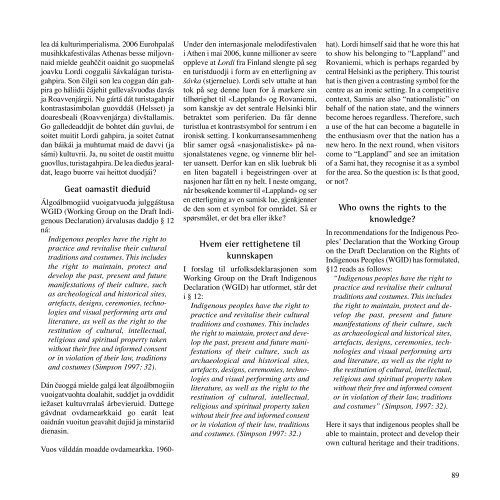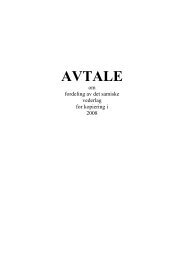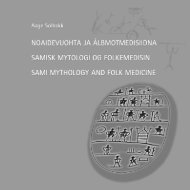Duodji - hvem eier kunnskapen og verkene?
Duodji - hvem eier kunnskapen og verkene?
Duodji - hvem eier kunnskapen og verkene?
Create successful ePaper yourself
Turn your PDF publications into a flip-book with our unique Google optimized e-Paper software.
lea dá kulturimperialisma. 2006 Eurohpalaš<br />
musihkkafestiválas Athenas besse miljovnnaid<br />
mielde geahččit oaidnit go suopmelaš<br />
joavku Lordi c<strong>og</strong>galii šávkalágan turistagahpira.<br />
Son čilgii son lea c<strong>og</strong>gan dán gahpira<br />
go háliidii čájehit gullevašvuođas davás<br />
ja Roavvenjárgii. Nu gártá dát turistagahpir<br />
kontrastasimbolan guovddáš (Helsset) ja<br />
doaresbeali (Roavvenjárga) divštallamis.<br />
Go galledeaddjit de bohtet dán guvlui, de<br />
soitet muitit Lordi gahpira, ja soitet čatnat<br />
dan báikái ja muhtumat maid de davvi (ja<br />
sámi) kultuvrii. Ja, nu soitet de oastit muittu<br />
guovllus, turistagahpira. De lea dieđus jearaldat,<br />
leago buorre vai heittot duodjái?<br />
Geat oamastit dieđuid<br />
Álgoálbm<strong>og</strong>iid vuoigatvuođa julggáštusa<br />
WGID (Working Group on the Draft Indigenous<br />
Declaration) árvalusas daddjo § 12<br />
ná:<br />
Indigenous peoples have the right to<br />
practice and revitalise their cultural<br />
traditions and costumes. This includes<br />
the right to maintain, protect and<br />
develop the past, present and future<br />
manifestations of their culture, such<br />
as archeol<strong>og</strong>ical and historical sites,<br />
artefacts, designs, ceremonies, technol<strong>og</strong>ies<br />
and visual performing arts and<br />
literature, as well as the right to the<br />
resti tution of cultural, intellectual,<br />
religious and spiritual property taken<br />
without their free and informed consent<br />
or in violation of their law, traditions<br />
and costumes (Simpson 1997: 32).<br />
Dán ču<strong>og</strong>gá mielde galgá leat álgoálbm<strong>og</strong>iin<br />
vuoigatvuohta doalahit, suddjet ja ovddidit<br />
iežaset kultuvrralaš árbevieruid. Dattege<br />
gávdnat ovdamearkkaid go earát leat<br />
oaidnán vuoitun geavahit dujiid ja minstariid<br />
dienasin.<br />
Vuos válddán moadde ovdamearkka. 1960<br />
Under den internasjonale melodifestivalen<br />
i Athen i mai 2006, kunne millioner av seere<br />
oppleve at Lordi fra Finland slengte på seg<br />
en turistduodji i form av en etterligning av<br />
šávka (stjernelue). Lordi selv uttalte at han<br />
tok på seg denne luen for å markere sin<br />
tilhørighet til «Lappland» <strong>og</strong> Rovaniemi,<br />
som kanskje av det sentrale Helsinki blir<br />
betraktet som periferien. Da får denne<br />
turistlua et kontrastsymbol for sentrum i en<br />
ironisk setting. I konkurransesammenheng<br />
blir samer <strong>og</strong>så «nasjonalistiske» på nasjonalstatenes<br />
vegne, <strong>og</strong> vinnerne blir helter<br />
uansett. Derfor kan en slik luebruk bli<br />
en liten bagatell i begeistringen over at<br />
nasjonen har fått en ny helt. I neste omgang,<br />
når besøkende kommer til «Lappland» <strong>og</strong> ser<br />
en etterligning av en samisk lue, gjenkjenner<br />
de den som et symbol for området. Så er<br />
spørsmålet, er det bra eller ikke?<br />
Hvem <strong>eier</strong> rettighetene til<br />
<strong>kunnskapen</strong><br />
I forslag til urfolksdeklarasjonen som<br />
Working Group on the Draft Indigenous<br />
Declaration (WGID) har utformet, står det<br />
i § 12:<br />
Indigenous peoples have the right to<br />
practice and revitalise their cultural<br />
traditions and costumes. This includes<br />
the right to maintain, protect and develop<br />
the past, present and future manifestations<br />
of their culture, such as<br />
archaeol<strong>og</strong>ical and historical sites,<br />
artefacts, designs, ceremonies, technol<strong>og</strong>ies<br />
and visual performing arts and<br />
literature, as well as the right to the<br />
restitution of cultural, intellectual,<br />
religious and spiritual property taken<br />
without their free and informed consent<br />
or in violation of their law, traditions<br />
and costumes. (Simpson 1997: 32.)<br />
hat). Lordi himself said that he wore this hat<br />
to show his belonging to “Lappland” and<br />
Rovaniemi, which is perhaps regarded by<br />
central Helsinki as the periphery. This tourist<br />
hat is then given a contrasting symbol for the<br />
centre as an ironic setting. In a competitive<br />
context, Samis are also “nationalistic” on<br />
behalf of the nation state, and the winners<br />
become heroes regardless. Therefore, such<br />
a use of the hat can become a bagatelle in<br />
the enthusiasm over that the nation has a<br />
new hero. In the next round, when visitors<br />
come to “Lappland” and see an imitation<br />
of a Sami hat, they rec<strong>og</strong>nise it as a symbol<br />
for the area. So the question is: Is that good,<br />
or not?<br />
Who owns the rights to the<br />
knowledge?<br />
In recommendations for the Indigenous Peoples’<br />
Declaration that the Working Group<br />
on the Draft Declaration on the Rights of<br />
Indigenous Peoples (WGID) has formulated,<br />
§12 reads as follows:<br />
“Indigenous peoples have the right to<br />
practice and revitalise their cultural<br />
traditions and costumes. This includes<br />
the right to maintain, protect and develop<br />
the past, present and future<br />
manifestations of their culture, such<br />
as archaeol<strong>og</strong>ical and historical sites,<br />
artefacts, designs, ceremonies, technol<strong>og</strong>ies<br />
and visual performing arts<br />
and literature, as well as the right to<br />
the restitution of cultural, intellectual,<br />
religious and spiritual property taken<br />
without their free and informed consent<br />
or in violation of their law, traditions<br />
and costumes” (Simpson, 1997: 32).<br />
Here it says that indigenous peoples shall be<br />
able to maintain, protect and develop their<br />
own cultural heritage and their traditions.<br />
89




